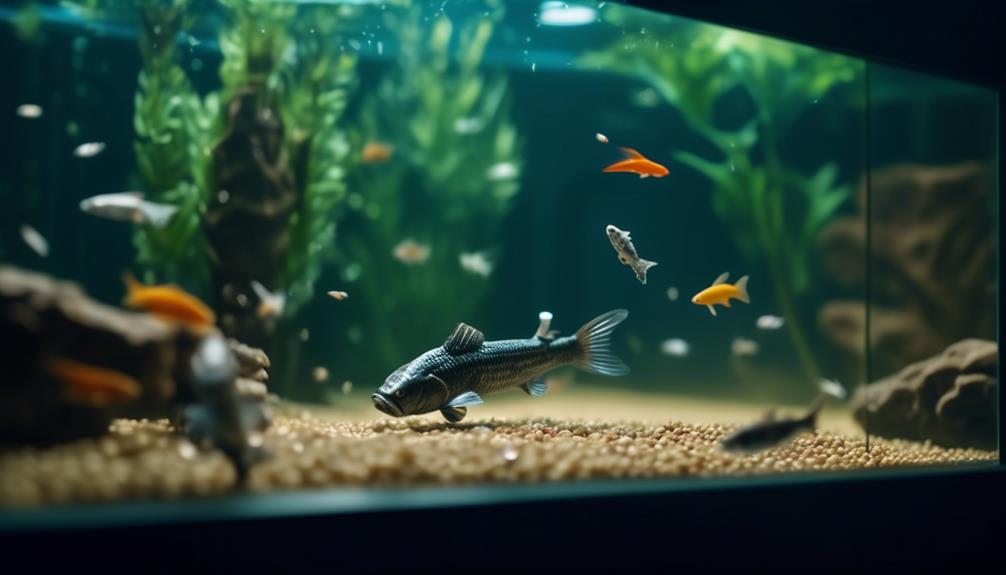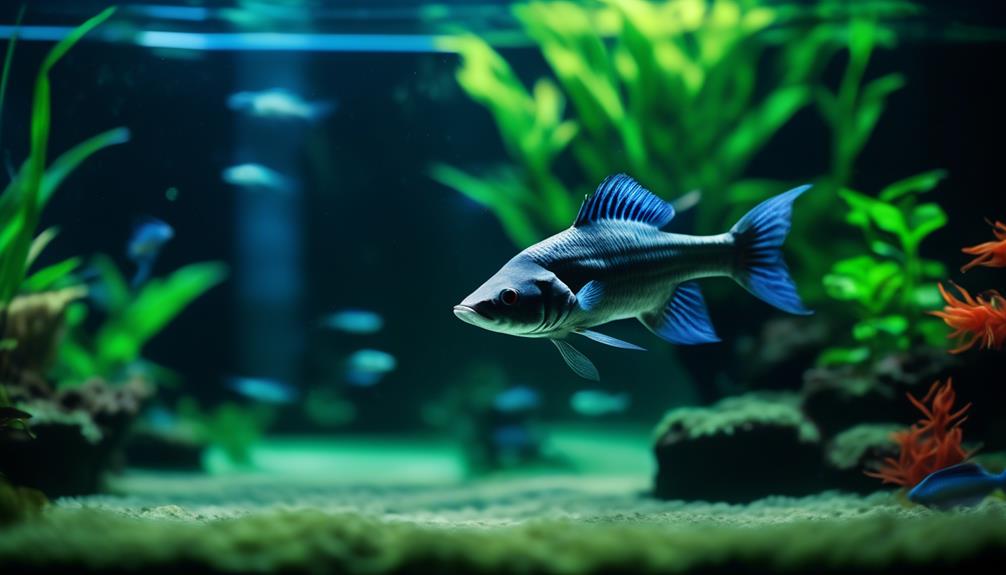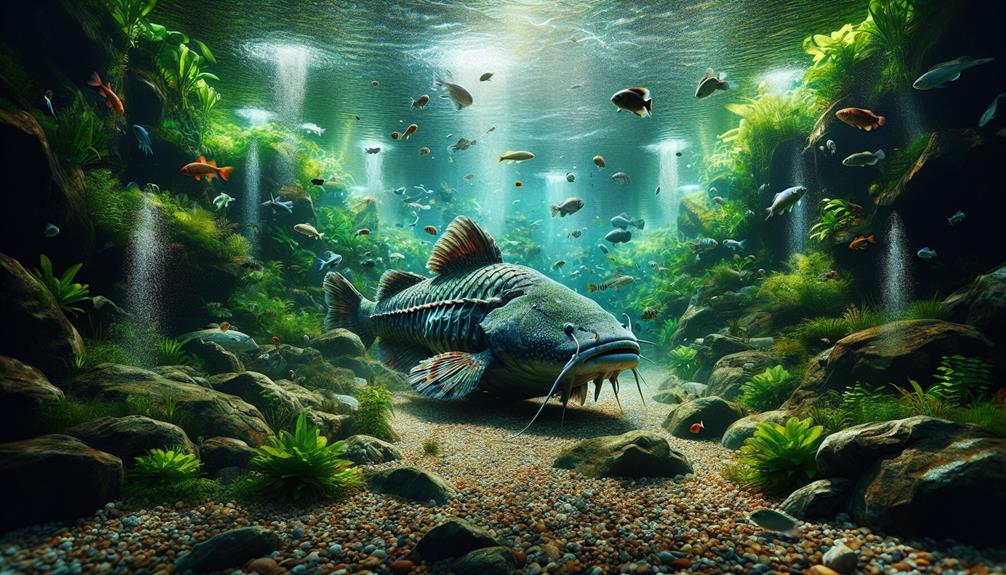Welcome to the world of pleco care, where we will explore the fascinating realm of the mighty armored catfish. These intriguing creatures, scientifically known as the Loricariidae family of armored suckermouth catfish, originate from the vibrant waters of Central and South America.
In this comprehensive guide, we will not only discuss their habitat and tank requirements but also delve into the intricacies of their feeding habits and compatibility with other fish species.
Whether you are a beginner or an experienced aquarist, this guide promises to equip you with valuable insights and practical tips to ensure the well-being of your plecos.
So, join us as we dive into the world of pleco care and unravel the secrets of these remarkable armored catfish.
Key Takeaways
- Plecos come in various species, with smaller ones like bristlenose, rubber lip, and clown plecos being more suitable for home aquariums.
- Plecos require a well-balanced diet and should not solely rely on algae wafers. Frozen bloodworms and Repashy gel food are good options for feeding them.
- Regular tank maintenance is necessary to keep nitrate levels below 40 ppm and to ensure the overall health of the plecos.
- When keeping plecos with other fish, it's important to choose peaceful, compatible species and provide enough hiding spots and caves for everyone to feel secure.
Overview and Habitat
The Plecostomus, also known as the Loricariidae family of armored suckermouth catfish, is a fascinating aquatic species originating from Central and South America. This species exhibits a remarkable diversity, with various pleco species showcasing distinctive features and behaviors.
Plecos are known for their ability to attach themselves to surfaces using their unique suckermouths, which allows them to cling onto rocks, glass, and other objects in their natural habitat. They are primarily bottom-dwelling fish, spending their time scavenging for food and seeking shelter among rocks, caves, and vegetation.
Plecos are known to be nocturnal, meaning they are most active during the night. Understanding the natural behavior and habitat preferences of plecos is crucial for creating a suitable environment in captivity that mimics their natural habitat and promotes their overall well-being.
Tank Requirements
To create an optimal environment for plecos in captivity, it is essential to meet their specific tank requirements. Plecos are armored catfish that require proper tank decoration and filtration to thrive.
Tank decoration should include caves, driftwood, and rocks to provide hiding spots and cover for their nocturnal nature. These features also mimic their natural habitat in Central and South America.
Proper filtration is crucial to maintain water quality and remove waste. A good filtration system should be able to handle the bioload of plecos, as they can produce a significant amount of waste. It is recommended to use a combination of mechanical, biological, and chemical filtration to ensure the water remains clean and free from harmful substances.
Feeding Guidelines

When it comes to ensuring the health and well-being of plecos in captivity, understanding their dietary needs and following proper feeding guidelines is crucial. Plecos have specific feeding habits and dietary preferences that must be met in order for them to thrive.
While algae wafers are commonly used, they should not be the sole source of nutrition for plecos. It is important to provide a well-balanced diet that includes other food options such as frozen bloodworms and Repashy gel food.
Feeding plecos when the lights are off allows them to feed while other fish are less active. It is also important to adjust their food portion size to maintain a healthy weight.
Maintaining Water Quality
In order to ensure the optimal health and well-being of plecos in captivity, maintaining the water quality of their aquarium is of utmost importance. Here are some key steps to take in order to maintain water quality:
- Regularly test the water parameters, including pH, ammonia, nitrite, and nitrate levels, to ensure they are within the appropriate range for plecos.
- Perform regular water changes to remove any accumulated toxins and replenish essential minerals and nutrients.
- Use a high-quality filtration system to keep the water clean and clear.
- Avoid overfeeding the plecos, as excess food can contribute to increased ammonia levels.
- Implement nitrate management strategies, such as adding live plants or using nitrate-reducing products, to keep nitrate levels under control.
Compatibility With Other Fish

Plecos exhibit a range of compatibility with other fish species, making it essential to consider their behavior and size when selecting tankmates. Some pleco species can be territorial, so it is important to research their behavior before keeping multiples. Providing enough caves and hides is essential for the well-being of all tank inhabitants. To assist in selecting suitable tank mates for plecos, the following table provides an overview of some common fish species that are compatible with plecos:
| Fish Species | Size | Behavior |
|---|---|---|
| Guppies | Small | Peaceful |
| Tetras | Small | Peaceful |
| Corydoras | Small | Peaceful |
| Angelfish | Medium | Peaceful |
| Gouramis | Medium | Peaceful |
It is important to note that this table is not exhaustive, and compatibility can vary depending on individual fish temperament. It is always advisable to monitor the tank and observe how the fish interact to ensure a harmonious community.
Frequently Asked Questions
How Long Do Plecos Typically Live in Captivity?
The lifespan of plecos in captivity varies depending on the species and the care provided. On average, plecos can live anywhere from 10 to 15 years, but some species have been known to live up to 20 years. Proper tank size is crucial for their health and longevity.
Can Plecos Be Kept in a Community Tank With Aggressive Fish?
Plecos can be kept in a community tank with peaceful fish that won't harm them. However, it's important to avoid adding aggressive fish or those small enough to fit in the pleco's mouth. Providing ample hiding spots and caves is also essential for their well-being.
Are There Any Health Issues or Diseases That Plecos Are Prone To?
Plecos may be prone to various health issues and diseases, including swim bladder disorders, bacterial and fungal infections, and parasitic infestations. Regular observation, proper nutrition, and maintaining optimal water conditions are key to preventing and addressing these issues.
What Are Some Signs That Indicate a Pleco Is Stressed or Unhealthy?
Signs of pleco stress and common pleco diseases include loss of appetite, lethargy, rapid breathing, unusual swimming behavior, visible physical abnormalities, and fin rot. Regular observation and prompt veterinary care are essential for maintaining pleco health.
Are There Any Specific Breeding Requirements or Considerations for Plecos?
Breeding plecos requires specific techniques and considerations. A separate breeding tank with appropriate water parameters, such as slightly lower temperature and pH, is necessary. Provide caves or PVC pipes for spawning, and ensure adequate filtration and water quality.
Conclusion
In conclusion, the care of plecos requires careful attention to their habitat, tank requirements, feeding habits, and water quality. By providing the appropriate tank size and temperature range, offering a balanced diet, and maintaining optimal water conditions, plecos can thrive in captivity.
It is crucial to understand that plecos have specific dietary needs and should be treated as living animals. For example, a case study showed that by providing a varied diet of algae, vegetables, and protein-rich foods, a pleco's health and vitality significantly improved.

